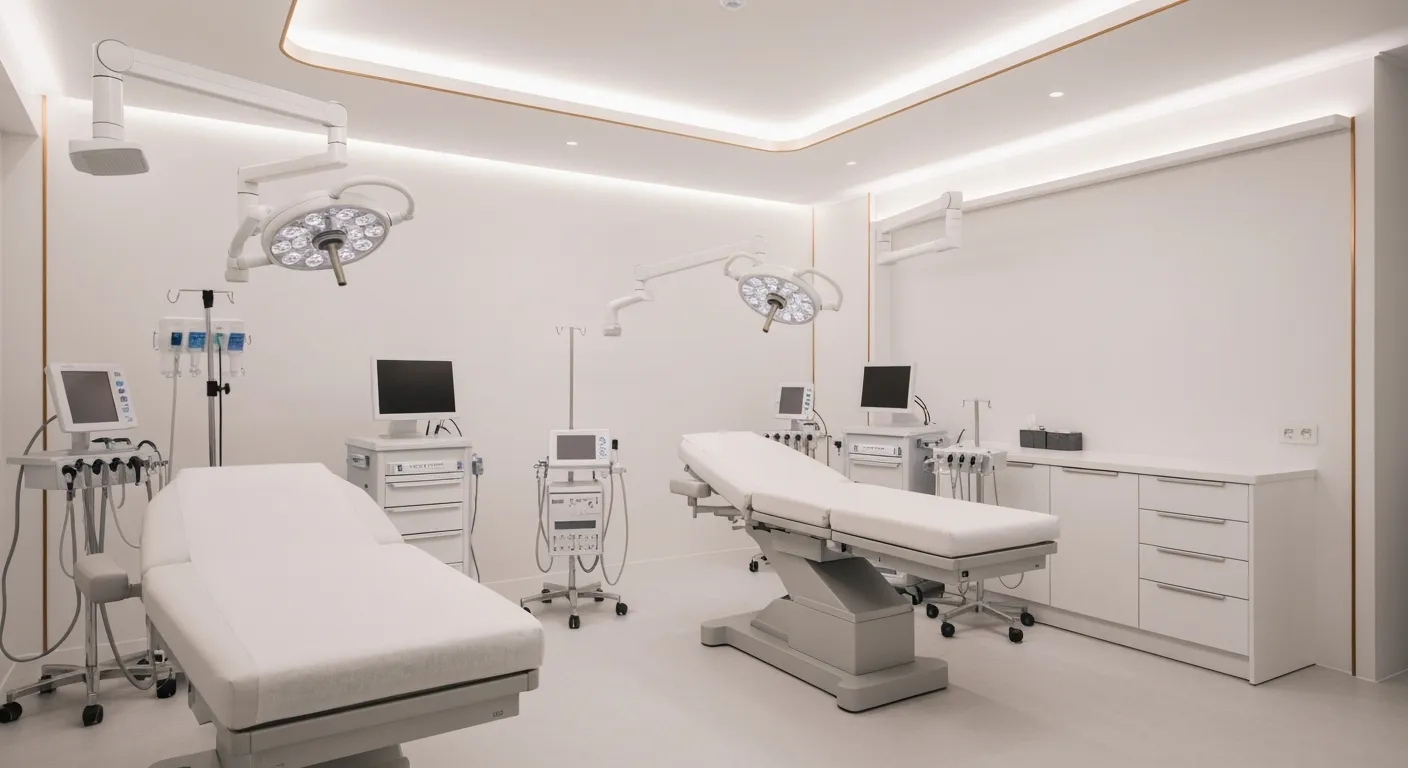
November 26, 2025
How to Get Rid of Jowls Without Surgery: A Practical Guide
Learn how to get rid of jowls without surgery with natural treatments, exercises, and skincare tips that actually work.
Oct 10, 2025

Plastic surgery encompasses a wide array of procedures designed to restore function or enhance appearance. Whether reconstructive or cosmetic, these surgeries play a transformative role in improving patients' lives. This article addresses the most frequently asked questions about plastic surgery, providing expert answers on everything from surgeon qualifications and patient eligibility to safety considerations and recovery processes, helping prospective patients make informed decisions.

Plastic surgery is generally categorized into two main types: reconstructive surgery aims to restore function and appearance to abnormal or damaged body parts. It includes treatments such as repairing congenital deformities like cleft lip and palate, burn reconstruction, scar revision, and tumor removal. These procedures are often covered by insurance because they address physical impairments caused by injury or disease.
In contrast, cosmetic surgery focuses on improving physical appearance and self-esteem. It involves procedures like breast augmentation, rhinoplasty, liposuction, facelifts, and tummy tucks. Cosmetic procedures are usually elective and not covered by insurance. They can be performed surgically, requiring incisions, anesthesia, and longer recovery times, or minimally invasive, such as Botox injections, dermal fillers, chemical peels, and laser treatments.
Common surgical procedures include nose reshaping (rhinoplasty), ear pinning (otoplasty), eyelid surgery (blepharoplasty), and breast surgeries. Non-surgical options like Botox temporarily paralyze muscles to reduce wrinkles, while dermal fillers add volume to soft tissues. Each procedure has specific goals and considerations, and qualified plastic surgeons tailor treatments to individual needs.
Understanding the differences between these procedures helps patients make informed decisions aligning with their health status and aesthetic goals. When considering any surgery, it’s essential to consult with an experienced, board-certified plastic surgeon to evaluate options, understand risks, and set realistic expectations.

When choosing a plastic surgeon, it is essential to confirm that they possess the appropriate education, training, and certifications to ensure safety and expertise. A qualified plastic surgeon must have graduated from an accredited medical school and completed a comprehensive residency program in plastic and reconstructive surgery, which typically lasts at least six years. This extensive training includes both general surgery and specialized procedures focused on the face, body, and skin (Plastic surgeon training and certification).
In addition to completing their training, the surgeon should be certified by recognized certifying bodies such as the American Board of Plastic Surgery (ABPS) or the Royal College of Physicians and Surgeons of Canada. This certification involves rigorous written and oral examinations that verify the surgeon's knowledge, skills, and competence in both reconstructive and cosmetic procedures. Certification must be maintained through ongoing education and periodic re-certification, demonstrating a commitment to staying current with advancements in the field (Board-certified plastic surgeon requirements, Surgeon Certification Requirements).
For those practicing aesthetic or cosmetic surgery specifically, additional certification from specialized boards like the Accreditation for Certification in Cosmetic Surgery (ABCS) can indicate extensive experience and training in cosmetic procedures. These certifications confirm that the surgeon has performed a minimum number of surgeries, completed additional training, and passed comprehensive exams (Choosing a Board Certified Cosmetic Surgeon).
Beyond certification, the surgeon should operate within accredited surgical facilities that meet high safety standards. It is also vital that they hold current, unrestricted medical licenses and have hospital privileges for their surgical procedures. These credentials collectively assure that the surgeon adheres to ethical standards, follows strict safety protocols, and maintains ongoing professional development, all of which are critical for patient safety and achieving optimal surgical outcomes (Surgical Facility Accreditation, State-Licensed Surgical Facility).

Patient eligibility for plastic surgery is primarily based on an individual's overall physical health, psychological readiness, and realistic expectations. Candidates should have stable vital signs, no uncontrolled medical issues such as severe hypertension, diabetes, or autoimmune disorders, and typically a body mass index (BMI) below 30, although some procedures may accommodate a BMI up to 33. Psychological factors are equally important; patients should demonstrate mental health stability and have a clear understanding of the achievable results. Conditions like Body Dysmorphic Disorder, severe depression, or post-traumatic stress disorder may disqualify someone, as unrealistic expectations can impact satisfaction (Plastic Surgery FAQ, Plastic surgery FAQs, Plastic Surgery FAQ: Patient Safety Questions).
Non-smokers are preferred because smoking impairs wound healing and increases the risk of complications. Timing considerations include avoiding surgery during pregnancy or plans for future pregnancy, and encouraging healthy lifestyle habits such as maintaining a stable weight and avoiding tobacco use prior to the procedure (11 Expert Tips from a Plastic Surgeon: How to Prepare for Cosmetic Surgery Recovery, Plastic Surgery and Smoking Risks). Surgeons assess each patient’s medical history, previous surgical experiences, and willingness to follow post-operative instructions to ensure safety and successful outcomes. Multiple factors, including individual health assessments and specific procedure requirements, help determine if a patient is a suitable candidate (What is Plastic Surgery?, Questions to Answer Before Plastic Surgery).
Preparation for a plastic surgery consultation involves several steps to ensure a productive and informative appointment. Patients should conduct thorough research on the procedures they are considering and compile a comprehensive medical history, including allergies, current medications, supplements, and any prior surgeries or medical conditions (Preparing for your cosmetic surgery consultation, Plastic Surgery Consultation Checklist). Wearing appropriate clothing, particularly for procedures involving disrobing or specific body areas, facilitates examination and discussion.
Bringing visual references such as photographs of desired outcomes helps communicate expectations clearly. Preparing a detailed list of questions about the surgeon’s experience, safety protocols, anesthesia options, recovery timelines, potential risks, and costs is vital. Patients should also consider their personal goals and be open to professional guidance, understanding that the surgeon’s recommendations are tailored to their individual anatomy and health (Questions to Ask Your Plastic Surgeon, Choosing a Board Certified Cosmetic Surgeon).
Furthermore, consulting with multiple surgeons can provide different perspectives and help compare practices, safety standards, and pricing. Reviewing before-and-after photos of previous patients can clarify aesthetic preferences. Finances should also be considered—discussing payment plans or financing options like CareCredit—in advance ensures no delays once the decision to proceed is made. Overall, being well-prepared enables patients to make informed choices and set realistic expectations for their surgical journey (Cosmetic Surgery Financing Options, Questions to Ask Your Cosmetic Surgeon).
To ensure safety and quality, patients should verify that their plastic surgeon is certified by the American Board of Plastic Surgery (ABPS). Certification confirms that the surgeon has completed extensive training, including multiple years of postgraduate education, and has passed rigorous exams. Patients should also review the surgeon's experience with the specific procedure they are considering, including the number of times they have performed it.
Checking before-and-after photos of previous patients, reading reviews or seeking referrals can help gauge the surgeon’s skill and aesthetic results. It’s important to confirm that the surgery will be performed in an accredited surgical facility, such as those approved by JCAHO or AAASF. These certifications indicate adherence to safety standards.
Communication is vital. Patients should feel comfortable discussing their goals and expectations openly with the surgeon. They should also verify the surgeon's hospital privileges and membership in reputable professional organizations like the American Society of Plastic Surgeons (ASPS) to further validate their credibility. Establishing trust and ensuring the surgeon's qualifications are foundational steps toward a safe and satisfying outcome.
Despite their generally high safety standards, all surgeries carry inherent risks. Selecting a board-certified, experienced surgeon significantly reduces these risks. Comprehensive preoperative evaluation, including medical history and physical assessments, helps identify and mitigate risk factors.
Common potential complications include infection, abnormal scarring, blood clots, bleeding, nerve damage, and anesthesia-related issues. Postoperative wound healing problems and unexpected scarring are also concerns. For minimally invasive procedures like fillers and Botox, risks include allergic reactions, infection, bruising, and in rare cases, serious complications such as blindness if not properly administered.
Patients can reduce risk by following all pre- and post-surgical instructions, such as avoiding smoking and certain medications that increase bleeding risk. Transparency with the surgeon about health conditions and realistic expectations are crucial. Ultimately, choosing a qualified surgeon practicing in an accredited facility and maintaining open communication further enhances safety and reduces the likelihood of complications.
The recovery period following plastic surgery varies depending on the specific procedure performed. Generally, it involves managing discomfort through prescribed pain medications and reducing swelling with ice packs or cold compresses. Patients should meticulously follow their surgeon’s instructions regarding wound care, including wound dressings, drains, and sutures. Rest and restricted activity are crucial initially; patients are advised to avoid strenuous movements, heavy lifting, and driving until their surgeon approves. Maintaining good hydration and eating light, nutrient-rich foods can support healing. Monitoring for signs of infection such as redness, fever, or excessive swelling is important—prompt medical attention may be necessary if these occur. For detailed guidance, see Postoperative care instructions and Plastic surgery recovery tips.
Patients should adhere to all postoperative guidelines provided by their surgeon. This includes avoiding smoking, which can impair healing, and protecting scars from sun exposure with clothing or sunscreen to prevent pigmentation changes. Elevating the surgical area, sleeping in a reclined position, and using compression garments if recommended can help reduce swelling. It’s also advised to limit alcohol intake and follow nutritional guidelines to support tissue repair. Comprehensive post-surgery care advice is available at Post-Surgical Care Instructions and 11 Expert Tips from a Plastic Surgeon.
Scheduled follow-up visits are vital for assessing healing progress, removing stitches if necessary, and monitoring for any complications like infection, hematoma, or adverse reactions. Surgeons often check for proper wound healing and provide scar management advice, such as silicone gels or massage techniques. Patients must communicate any unusual symptoms such as severe pain, increased swelling, or signs of infection immediately. For more information, see Plastic Surgery FAQ: Patient Safety Questions and Your Consultation Checklist: Essential Questions to Ask Before Your Plastic Surgery Procedure.
Long-term care involves consistent scar management, which may include scar creams, silicone sheets, or laser treatments to improve appearance. Protecting scars from sun exposure helps prevent hypertrophic scarring or hyperpigmentation. Maintaining a stable weight, a healthy diet, and regular exercise contribute to sustained results. Avoiding smoking and alcohol and practicing sun safety are critical for optimal healing and long-lasting aesthetic outcomes. Patience is necessary, as final results—particularly scar maturation—can take many months to fully develop. Additional resources on scar care and lifestyle considerations can be found at Plastic surgery recovery tips and Realistic expectations for cosmetic surgery.
Patients interested in plastic surgery should be aware that procedure costs can vary significantly based on the type of treatment, the surgeon's expertise, and the geographic location of the practice. Typically, surgical procedures like liposuction and breast augmentation cost between $3,700 and $7,800, while non-surgical treatments such as Botox average around $420 per session.
To make these procedures more accessible, many clinics provide various financing options. One popular choice is CareCredit, a healthcare credit card that offers promotional plans, such as 0% interest for certain periods, and does not charge an annual fee. Prequalification for CareCredit can be done online without affecting credit scores, allowing patients to see what they might qualify for comfortably.
CareCredit also features an online cost estimator tailored to your geographic area and has a broad network of providers accepting the credit. Though insurance usually does not cover cosmetic surgeries, some medically necessary reconstructive procedures might be an exception. See more on Cosmetic Surgery Insurance Coverage.
In addition to external financing options, some clinics offer in-house payment plans or installment arrangements to help split the cost into manageable payments. Patients are encouraged to discuss all available options with their provider, compare the costs and terms of different plans, and choose the solution that best fits their budget and needs. For more guidance on financing, see CareCredit Financing Options.
Patients should approach plastic surgery with realistic expectations for cosmetic surgery. While procedures often improve appearance and boost self-esteem, perfection is rarely achievable. Common complications can include scarring prevention and management, asymmetry, swelling, infection, nerve injury, and blood clots. Higher-risk procedures like thigh lifts or injectables may carry increased complication rates. Rare but severe risks such as deep vein thrombosis, pulmonary embolism, and permanent vision loss can occur, especially if safety guidelines in plastic surgery are not strictly followed. Even minimally invasive procedures might result in adverse events like granulomas or infections, particularly when performed by untrained providers. To minimize these risks, thorough patient selection, comprehensive preoperative evaluation procedures, and precise post-operative care instructions are critical to successful outcomes.
Many misconceptions surround plastic surgery. A prevalent myth is that all results look unnatural, though modern techniques often ensure natural appearances as explained in Natural results in plastic surgery. Some believe plastic surgery is painless; however, technological advancements have significantly reduced discomfort as covered under Managing pain after plastic surgery. There’s also a misconception that plastic surgery is only for the wealthy or vain; in fact, it is increasingly accessible and covers both aesthetic and reconstructive needs for diverse populations, detailed in Cosmetic surgery overview. Another false belief is that surgeries guarantee permanent results—aging and lifestyle factors mean that results may diminish over time (Realism of surgical expectations). Additionally, many assume all surgeons are equally qualified, but board-certified plastic surgeons have specialized training that distinguishes their expertise. Understanding these myths helps in making informed decisions and setting realistic expectations about plastic surgery’s possibilities and limits.
Choosing plastic surgery is a significant decision that requires careful consideration, thorough research, and collaboration with qualified professionals. Understanding the different procedures, verifying surgeon qualifications, knowing candidacy requirements, and being aware of safety and recovery protocols are foundational to a positive experience. By dispelling common myths and embracing realistic expectations, patients can navigate their options with confidence. Ultimately, transparent communication and proper planning empower individuals to achieve outcomes that enhance both appearance and well-being.

November 26, 2025
Learn how to get rid of jowls without surgery with natural treatments, exercises, and skincare tips that actually work.

November 25, 2025
how much botox costs explained: learn what affects pricing, average ranges, and tips to save on your treatment.

November 25, 2025
Understanding Key Insights and Facts About Plastic Surgery